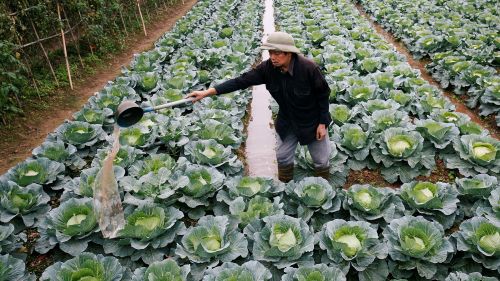Adopting Conserving Agricultural Practices: A Farmer's Perspective

Farmers’ decisions to change the way they have farmed for years and start using new conserving agricultural practices such as conservation tillage, cover cropping, or buffer strips will depend in large part on how much it will cost.
Assistance for Farmers
When farmers consider what practices to utilize in operating their farms, several factors are taken into account. However, the paramount consideration is the impact of adopting a new practice on the financial bottom line of their farming operation, since most farmer’s operations are the main, or a highly significant, source of income for their families.
Farmers care about the land and other natural resources that they steward, but they also need to do their best to ensure they can make a decent living from their work. The decision to change the way they have farmed for years and start using new conserving agricultural practices such as conservation tillage, cover cropping, or buffer strips will depend in large part on how much it will cost to implement those practices, and what benefits, in terms of reduced input costs and/or increased yields, they expect to generate from this new practice in order to offset those costs. There are also federal and state programs, and increasingly private-sector mechanisms such as environmental services markets, to provide financial or technical assistance or preferential marketing or credit arrangements to farmers adopting such practices to help defray their costs. This blog will focus on public sector incentives and assistance.
Financial and Technical Assistance is Available, but Demand is Strong
Some farmers have been able to defray the cost of adopting new practices by enrolling in voluntary conservation programs operated by the U.S. Department of Agriculture (USDA), which provides cost-share or another form of financial assistance to farmers whose proposals are approved for funding. There are two main programs, the Environmental Quality Incentives Program (EQIP) and the Conservation Stewardship Program (CSP), which& provide assistance to farmers changing practices on working farmland. Under EQIP, farmers, in general, may receive up to 75 percent cost-share for installing their practices, and up to 90 percent if they qualify as having limited resources or being socially disadvantaged, such as farmers beginning their farming career or military veterans. Under CSP, farmers are eligible for payments for implementing new practices under a CSP contract, which would cover some portion of the costs of doing so. Farmers are also eligible to seek technical assistance from USDA for help in planning and implementing the use of new conservation practices, whether they receive program funding or not.
According to 2019 CBO estimates, there will be approximately $3.9 billion available to fund farmers’ conservation efforts in the fiscal year 2020 between these two programs. However, program history shows that there is almost always more demand for both types of assistance (financial and technical) than can be met under existing funding levels. Between 2000 and 2010, only about 40 percent of projects proposed under the EQIP program were actually funded on average.
In addition, most state Natural Resource Conservation Services (NRCS) offices have a backlog of requests for assistance on a range of conservation activities from farmers in their states that would take months or even years at current resource levels to address, even if no additional requests are made. For example, the North Dakota state NRCS office had a backlog of 700 requests for wetland determinations as of 2016, a significant decline from the 4,000 request backlog in 2012, but still representing more than a year’s worth of work for that office.
A few states also have incentives in place to encourage farmers to adopt specific types of conserving practices. For example, both Maryland and Iowa have programs that provide per acre incentives to farmers to begin cover cropping on their farmland. For the 2019/20 crop year, Maryland farmers were eligible for as much as $90/acre in payments for planting cover crops in order to reduce agricultural runoff into the Chesapeake Bay. In Iowa, farmers have been eligible for a $5 per acre discount on their crop insurance premium for planting cover crops for the past two crop years, and the 2020/21 crop year is scheduled to be the last year of a three-year pilot program. In the first two years of the pilot, more than 300,000 acres were newly cover-cropped in Iowa.
One Farmer’s Approach to Adopting Conservation Practices
Annie Dee, her husband, and three young children moved from Florida to west-central Alabama in 1989 to start a new farming operation. The Dee River Ranch is now a 10,000-acre operation with mixed crop, livestock, and timber located primarily in Alabama, but they also cultivate some land across the state’s western border in Mississippi. Annie has been a participant in the Farm Journal Foundation’s Farmer Ambassador Program since 2014, and she, her brother Mike, and twin sons, Seth and Jesse, have won numerous awards in recent years for their outstanding stewardship of the land and other natural resources.
From a conservation standpoint, Annie’s top priorities have been managing soil health and conserving water and energy. Toward that end, Dee River Ranch has extensively used no-till cultivation and cover cropping on the cropland in the operation. In recent years, she has experimented with using a variety of different species in her cover crop seed mixture, to generate a variety of useful micro-organisms and structure in the fields’ topsoil. In recent years, her inclusion of tillage radishes and other edible greens in her cover crop seed mixture has brought gleaners from up to 60 miles away out to harvest those plants. They have several riparian buffers in sensitive locations on the farm to reduce fertilizer runoff into surface water. On the livestock side, she has introduced improved grass seed varieties mixed with native grasses to improve forage quality and soil and water retention properties.
In adopting many of these practices, she has enrolled in both of USDA’s major working lands conservation programs, EQIP and CSP, to receive financial assistance as well as utilizing technical assistance from Alabama NRCS staff. She also works with extension faculty at Auburn University and Mississippi State University to try new innovative practices and technologies.
The use of irrigation is relatively rare in the state of Alabama. As of 2018, less than two percent of all cropland in the state was irrigated. However, Annie and Mike built their first small reservoir in 2011, allowing them to irrigate 300 acres of corn. Today, their irrigation system covers nearly 3,000 acres. The farm uses GPS technology to improve the efficiency of the application of inputs like fertilizers and other agricultural chemicals. They are now experimenting with new technology to help them apply water from their center pivot irrigation sites when their crops need it, rather than on a routine schedule.
The decisions made by Annie, Mike, Seth, and Jesse to utilize a range of conserving agricultural practices on Dee River Ranch over the years has helped them not only survive financially but thrive. When they started their Dee River Ranch operation in 1989, their average corn yields were around 140 bushels per acre. Today, with the availability of irrigation and improved soil health due to their conservation practices, their corn yields average 220 bushels per acre, a nearly 60 percent increase over 30 years. That figure is 30 percent higher than the average gain in corn yield nationally over the same period. They achieved this position in part by taking advantage of the financial and technical assistance available to all farmers and thinking about their operation on a long-term, strategic basis.
Field Notes
The Chicago Council is pleased to launch a new blog series, "Breaking Ground," to explore how food systems innovation and agricultural research and development can empower farmers and feed the world. A special subsection of this series, "Field Notes," features voices from Feed the Future Innovation Labs and CGIAR centers.

